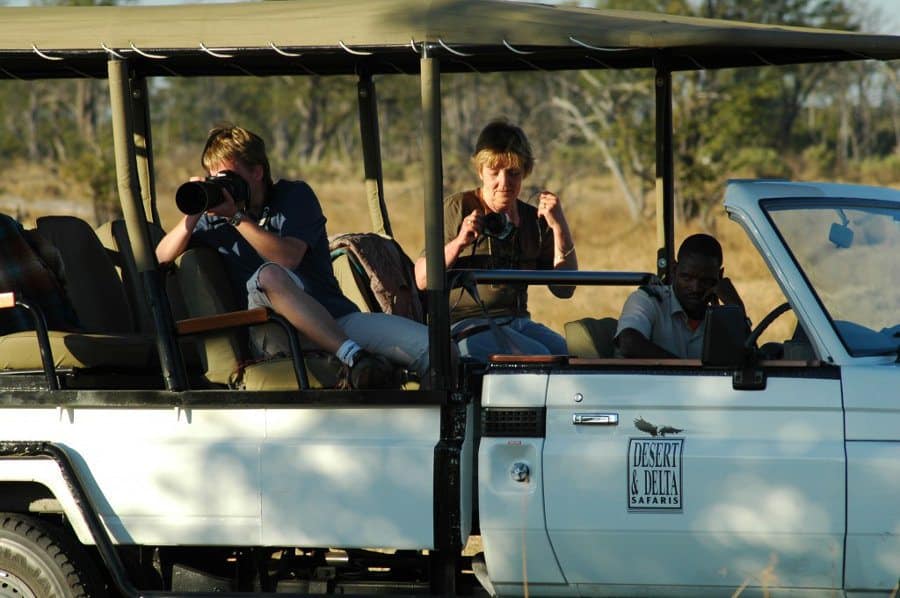Binoculars can make all the difference when you’re out on an African safari. Sometimes a leopard is hiding in a tree, and you can only see it with the best safari binoculars.
If you’re interested in birdlife, then binoculars are essential. Even when you’re relatively close to an animal, a good set of safari binoculars helps you zoom in on the details.
In most African national parks, you must stick to the trails. That means you can’t bump across the African savannah until you’re ten meters from a cheetah. You must watch it all from a distance.
While on a safari, there are always interesting things to see: both big and small. More often than not, it can be frustrating when you can’t see something or the action is taking place far away from your vehicle.
The following is a series of the top 11 things to consider when buying your safari binoculars. This way, you’ll be able to find the best pair for your next African adventure.
Spoiler alert – I’m not going to try to sell you binoculars. My own pair is an old Russian army brand, and they have worked out best for me. With binoculars, it’s all about choosing what’s most convenient for your needs.
Best Binoculars for Safaris: 11 Things to Consider
There are many things to consider when looking for the right pair of safari binoculars. 8x or 10x? Large or compact? Nikon or Bushnell?
To help make your purchase decision as seamless as possible, here are the top 11 things to keep an eye out for when buying binoculars for safari viewing.
1. Brand

The choice of binoculars is wide out there, and it can get confusing when it comes to choosing a brand.
Here’s a series of names I trust and recommend: Zeiss, Nikon, Canon, Bushnell, Pentax, Swarovski, Steiner, Leica, Olympus, Tento, Celestron, and Fujinon.
Each of these brands offers a range of high-quality binoculars. Below is a breakdown of the best pairs for various safari needs:
- Best compact binoculars for safari: Nikon Monarch M5 10×42.
- Best budget binoculars for safari: Bushnell 10×42 Engage X.
- Best travel binoculars for safari: Celestron 71347 Outland X.
- Best binoculars for game viewing: Swarovski 10×50.
- Best binoculars for birdwatching: Steiner 8×42 Safari.
2. Cost

My motto is to buy products that last, so I usually don’t hesitate to pay a little more than the average price.
However, at the end of the day, it all depends on the purpose of your purchase. And perhaps also how “careful” you are with your personal goods.
For my part, choosing a product that ranges between $200 and $300 is a safe bet. These generally feature metal housing and high-quality cut glass lenses with occasional anti-glare coating.
They may also come with an extended or lifetime warranty, which can be useful if you’re an avid safari-goer.
If budget is a concern for you, reasonable binoculars are already on offer for $100 (don’t go for anything less than that). Good models to start off with include the Pentax Papilio or the Nikon Monarch.
If you’d like something even cheaper, there are always ways to find second-hand binoculars, especially on the web. Look for places like eBay or Grovers Optics.
3. Eye relief
Eye relief is the optimal distance between your eye and the eyepiece (a combination of lenses at the viewing end of your binoculars).
When your eyes are either too close or too far away from the eyepieces, you cannot see the whole picture, and part of the image blacks out.
For people wearing glasses, it is best to have an eye relief of at least 15 mm (not applicable for people with good eyesight).
4. Field of view
The field of view (FOV) is the width of the view at a particular distance. Generally speaking, the greater the magnification, the narrower the field of view.
FOV becomes especially important when you are following fast-moving objects (such as Africa’s safari birds) or running mammals (like a cheetah chasing its prey). In this case, do not consider magnification greater than 8x.
For the best results on your African safari, choose a pair of binoculars with a field of view of at least 330 ft at 1000 yards.
5. Lens size/objective lens/aperture
Any pair of binoculars features a specific set of numbers, such as 8×42 or 10×50.
The second number represents the diameter of your objective lens. The larger the number, the more light passes through the lens, and the brighter and more colorful your image becomes.
Good lens size is a must when used in fading light or when looking at objects in the shade, for instance. For optimal results and enhanced image quality, go for “fully multi-coated” lenses.
In addition to this, the coating protects your lenses against scratches. The coated surface is also too slick for dirt or dust to adhere to, and it rarely fogs up, too.
6. Magnification of the safari binoculars: 8x or 10x or 12x

Magnification corresponds to how big you see a certain scene in comparison to how big or small it really looks from where you stand.
For example, a magnification power of 8x means that the image will be 8 times bigger than seen with the naked eye.
If the technical specification of a pair of binoculars is 10×50, then objects are magnified by 10, etc.
But what is the best binocular magnification for safaris?
Generally, you should avoid anything below 8x or above 10x. Below 8x offers a shorter range and poorer image quality, while greater than 10x is harder to focus.
For these reasons, it is best to stick to 8x or 10x. If you’re holding the binoculars without the assistance of a tripod, then magnification of 10 is ideal.
NB: While magnification is essential, image stability tends to decrease as you increase its importance.
For magnification greater than 10x, consider using a tripod or a window mount (some of the more expensive binoculars have built-in image stabilizing systems).
7. Purpose/usage

What is the purpose of your buy, and how do you intend to use your new pair of binoculars? Being clear on your purpose enables you to know how much you are willing to spend on them.
How often do you intend to use your safari binoculars? There is no need to spend hundreds (if not thousands in some cases) of dollars if you are only to use them once, so think carefully.
Are you more of a bird lover or an animal enthusiast? As stated previously (review the “Field of View” section), you cannot follow fast-moving things easily if your magnification is too big.
Let me recap:
- For bird viewing, use binoculars with a magnification of 8x maximum (8×42 for better results).
- For general animal spotting and optimal game viewing (or when you need to scan the horizon), consider buying 10×50 safari binoculars.
8. Quality/shock resistance
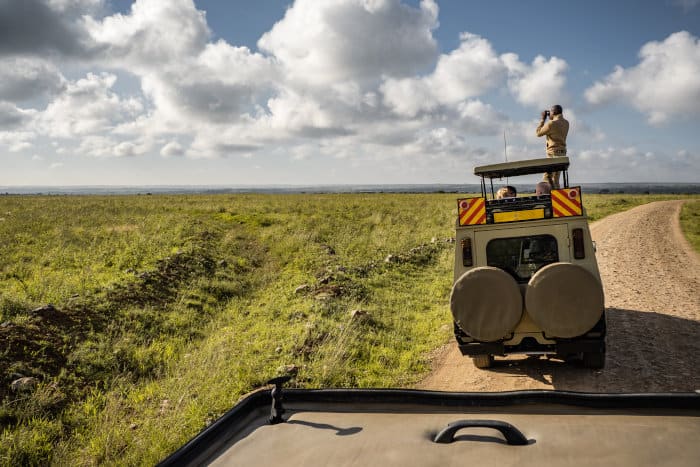
There are two essential aspects to reflect on: the “armoring of your binoculars” and the “glass quality” from which your prisms are made of.
Look for protective rubber (or synthetic housing) that prevents scratches and damage from bumpy roads.
Also, make sure that your prisms are BAK-4 models (instead of BK-7 or K9). They have a higher refractive index and provide superior levels of image quality.
9. Waterproofing

Optimum waterproofing not only protects your instrument from moisture and humidity but also prevents dust from damaging it.
10. Weight and size
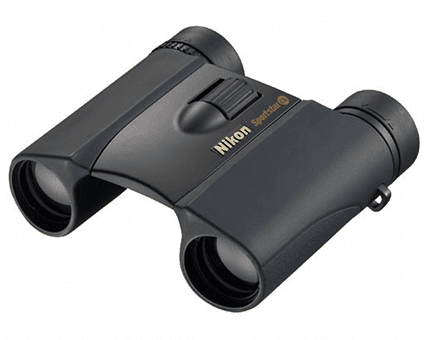
Think practicality. Compact binoculars are both light and easily transported anywhere. These are ideal for seeing birdlife on safari.
Disadvantage: Compact binoculars lose out in magnification, image detail and precision.
In other words, try to find a good compromise between your wants and your needs.
11. Binoculars type

It’s important to understand the different binocular types when searching for optical instruments for game viewing. The two key types you need to consider are the porro prism and roof prism binoculars.
Porro prism is the more traditional pair where the large objective lenses are offset from the eyepiece.
The roof prism has a more modern design. The lenses are in line with the eyepiece, allowing for a slim, compact look.
Other than the appearance, the key difference between the two binocular types relates to the way in which they reflect light from the objective lenses to the eyes.
With a roof prism pair, you will need greater precision for high-quality images.
On the other hand, porro prisms have an easier time producing a better quality image, making it the more favorable of the two.
My Own Pair of Binoculars for African Safaris
My personal pair of binoculars is made in Russia (Tento; army type), and I must say it is probably the best buy ever (despite their relatively heavy weight).
I have had them for over 20 years now, and they still provide the most amazing images. Besides, I have never had any problems with them (fingers crossed).
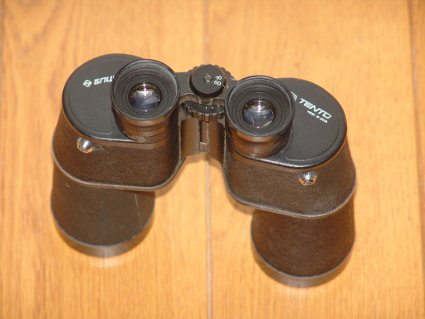

Test the Best Binoculars for African Safaris

I’d recommend buying a pair of binoculars long before you go on safari. It’s no use turning up to Africa without taking them out of the wrapper.
Purchase them at least a month before. That will give you time to practice using the binoculars, meaning you don’t waste any time when on safari.
You want to be the person in the safari vehicle who can tell if it’s a cheetah or leopard in the distant high grass.
Play with the settings before you travel because the best safari binoculars are only as good as the person using them!
Do You Need a Pair of Binoculars for Safari Trips?
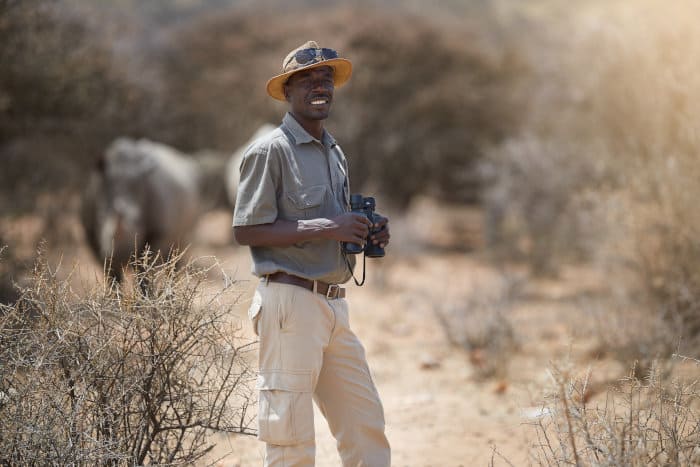
You now know how to choose binoculars for safaris, but you may be wondering if they are necessary.
For most, it helps to have binoculars on safari trips as the African animals and birds may not be as close as you think.
As such, safari binoculars are essential for getting a closer view. Just remember to opt for a robust pair with quality optics, and you’re good to go.
Get Your Binoculars for Safari Viewing
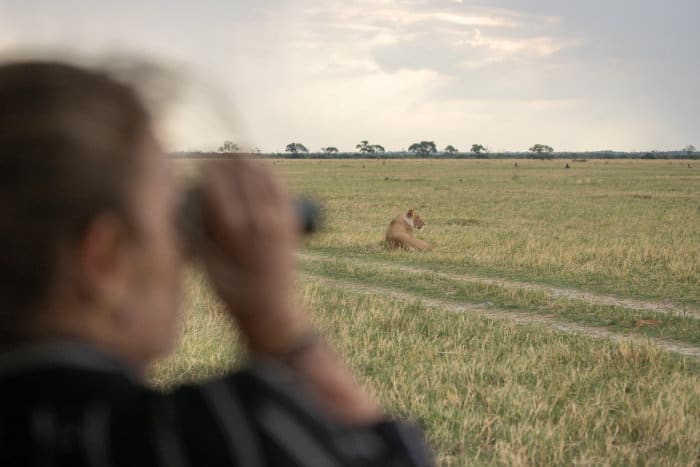
Now that you know what encompasses a good pair of binoculars, it’s time to take them out and discover the wild.
After all, there’s plenty to see that you might miss otherwise, including lions hiding in the grass, small antelope springing in the distance, and so much more.
Wondering where to start? Check out these incredible safari deals and start making the most out of your game viewing experiences with your trusty pair of safari binoculars!

